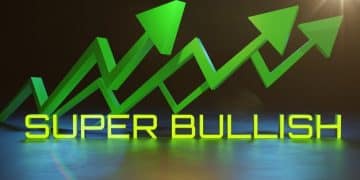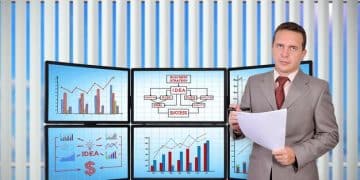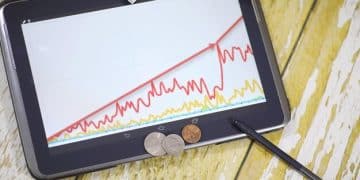Will the Fed Raise Interest Rates Again in Early 2025?
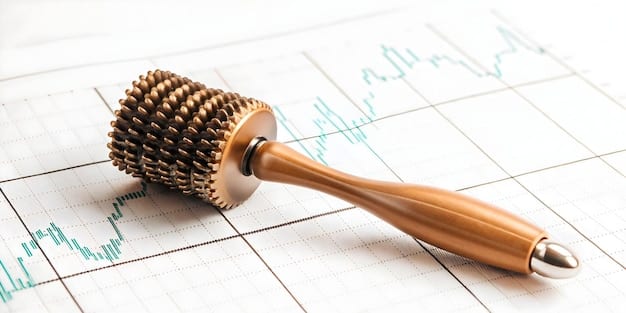
Navigating the complex landscape of monetary policy, the Federal Reserve’s potential decision to raise interest rates again in early 2025 hinges on a delicate balance of inflation trends, labor market dynamics, and global economic stability.
As the economic landscape continues its intricate dance, a compelling question lingers for investors, businesses, and everyday consumers: Will the Fed Raise Interest Rates Again in Early 2025? Expert Analysis and Economic Forecasts suggest a nuanced picture, far from a simple yes or no. Understanding the Federal Reserve’s potential moves requires a deep dive into the myriad factors influencing their decisions, from persistent inflationary pressures to the resilience of the labor market and broader geopolitical considerations.
Understanding the Federal Reserve’s Mandate and Current Stance
The Federal Reserve, often referred to as the Fed, operates under a dual mandate from Congress: to achieve maximum employment and stable prices. This dual objective forms the cornerstone of its monetary policy decisions, including actions related to the federal funds rate. Currently, the Fed has been engaged in a significant tightening cycle, raising interest rates to combat elevated inflation levels observed post-pandemic.
The journey to stable prices has been challenging, marked by supply chain disruptions, shifts in consumer demand, and geopolitical events. The Fed’s primary tool, the federal funds rate, directly influences borrowing costs across the economy, from mortgages to business loans. Higher rates typically cool down an overheating economy by making credit more expensive, thereby reducing demand and theoretically bringing down inflation. Conversely, lower rates stimulate economic activity.
As we approach early 2025, the Fed’s stance will be heavily informed by incoming economic data. Policymakers have repeatedly emphasized a data-dependent approach, meaning that future rate decisions are not predetermined but will respond directly to the evolution of economic conditions. This necessitates a close watch on key economic indicators, which serve as the compass for the Fed’s monetary policy direction.
Key Drivers of Fed Policy
Several critical factors consistently weigh on the Fed’s decision-making process. These drivers are meticulously analyzed by policymakers to gauge the health of the economy and the appropriate path for interest rates.
- Inflation Data: The Consumer Price Index (CPI) and the Personal Consumption Expenditures (PCE) price index are paramount. The Fed’s preferred measure, PCE, is closely monitored for signs that inflation is sustainably moving towards its 2% target. Persistent inflation, especially core inflation (excluding volatile food and energy prices), could prompt further rate hikes.
- Labor Market Strength: Employment statistics, including the unemployment rate, payroll gains, and wage growth, provide insights into the health of the economy. A robust labor market with strong wage growth can contribute to inflationary pressures, as higher wages often translate to increased consumer spending.
- Economic Growth Indicators: GDP growth, consumer spending, and business investment are vital signs of overall economic activity. A strong economy might tolerate higher rates, while signs of significant slowdown or recession could deter further tightening.
Understanding these core drivers is essential for anyone attempting to forecast the Fed’s next moves. Each data release provides a piece of the complex puzzle, guiding market expectations and, ultimately, the Fed’s policy trajectory. The ongoing challenge for the Fed lies in striking the right balance to combat inflation without inadvertently pushing the economy into a recession.
Economic Forecasts for Early 2025: A Mixed Bag
Forecasting economic trends is inherently challenging, especially with the multitude of variables at play. As we look towards early 2025, economists offer a range of perspectives on the likelihood of further Fed rate hikes, reflecting the complexities of the current economic environment. There is no unanimous consensus, highlighting the uncertainty that defines monetary policy decisions.
Many prominent financial institutions and economic think tanks are currently revising their projections. Some anticipate that the Fed may have reached the peak of its tightening cycle by late 2024, with early 2025 potentially seeing a period of rate stability or even initial cuts if inflation recedes faster than expected. This optimistic view often hinges on the assumption that disinflationary trends will continue to gather pace, and that the impact of previous rate hikes will fully manifest in the coming months.
Conversely, a substantial number of analysts maintain a more cautious outlook. They argue that underlying inflationary pressures, particularly in the services sector and due to a tight labor market, might prove more stubborn than anticipated. In this scenario, the Fed could be compelled to implement one or more additional rate hikes in early 2025 to ensure inflation definitively returns to its target. This perspective often emphasizes the risk of “premature easing” that could reignite inflationary pressures.
Inflationary Pressures: Transitory vs. Persistent
A central debate among economists revolves around the nature of current inflationary pressures. Initially seen as largely “transitory,” driven by supply chain bottlenecks and demand surges related to the pandemic, inflation has shown remarkable persistence. The argument for continued rate hikes often stems from the belief that a significant portion of inflation has become entrenched, necessitating further monetary tightening.
Factors contributing to this persistence include:
- Wage-Price Spiral Concerns: Continued strong wage growth, particularly in service sectors, raises concerns that higher labor costs could be passed on to consumers, feeding a cycle of rising prices and wages.
- Geopolitical Risks: Ongoing global conflicts and geopolitical tensions can disrupt supply chains and commodity markets, leading to renewed inflationary shocks that are difficult for central banks to control domestically.
- Housing Market Dynamics: While some housing indicators have cooled, persistent tightness in the rental market can keep shelter costs high, which are a significant component of inflation indices.
The distinction between transitory and sticky inflation is critical to the Fed’s strategy. If inflation is largely transitory, then current rates may eventually work their way through the system, bringing prices down. However, if structural or demand-side factors are more dominant, then more aggressive policy action, including potential rate hikes in early 2025, might be deemed necessary.
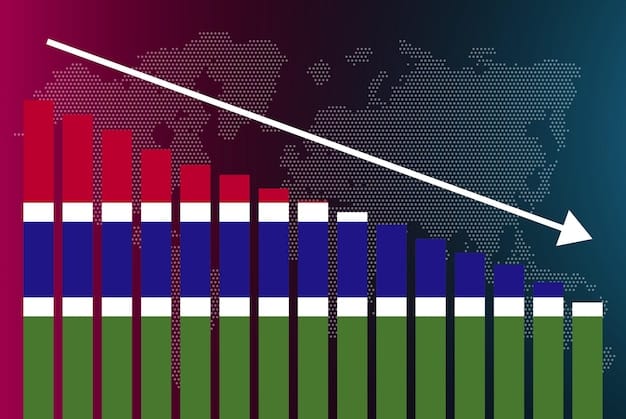
The State of the Labor Market: A Double-Edged Sword
The U.S. labor market has defied many predictions of significant weakening, maintaining surprising resilience despite aggressive monetary tightening by the Fed. This robust employment picture presents both a strength and a challenge for the central bank as it contemplates future rate decisions for early 2025.
On one hand, a strong labor market, characterized by low unemployment rates and consistent job creation, is a positive sign for the overall health of the economy. It suggests that businesses are still expanding and that consumers have the income to support spending. This aligns with the Fed’s mandate for maximum employment and provides a cushion against potential economic downturns.
However, the strength of the labor market can also be a significant contributor to inflationary pressures. When job openings outnumber available workers, businesses often resort to offering higher wages to attract and retain talent. While beneficial for individual workers, widespread wage growth can lead to increased purchasing power, which in turn can push up demand for goods and services, contributing to price increases. This phenomenon is often referred to as a “wage-price spiral” the Fed aims to avoid.
Key Labor Market Indicators to Watch
The Fed pays close attention to several labor market metrics to assess its temperature:
- Unemployment Rate: A consistently low unemployment rate signals a tight labor market.
- Non-Farm Payrolls: The monthly report on job creation provides a snapshot of employment growth. Sustained high numbers can indicate an economy running hot.
- Wage Growth: Measured by average hourly earnings, significant and widespread wage increases can fuel inflationary concerns.
- Job Openings and Quits Rate (JOLTS): These indicators reveal the balance between labor demand and supply, and worker confidence. A high number of job openings and a high quits rate often suggest a strong, competitive labor market.
If the labor market begins to show significant signs of cooling—for instance, a notable rise in the unemployment rate, sustained declines in job openings, or a moderation in wage growth—it could alleviate some of the inflationary pressures. Such a scenario might reduce the impetus for the Fed to raise rates in early 2025, potentially enabling them to hold rates steady or even consider cuts if other economic indicators align.
Conversely, if the labor market continues its unexpected strength into late 2024 and early 2025, with persistent wage pressures, the Fed might view an additional rate hike as necessary to ensure price stability. The delicate dance between employment and inflation will continue to be a primary determinant of Fed policy decisions.
Geopolitical and Global Economic Influences
While the Federal Reserve’s primary focus is on the domestic U.S. economy, it cannot operate in a vacuum. Global economic conditions and geopolitical events exert significant influence, creating headwinds and tailwinds that can complicate monetary policy decisions. As we look towards early 2025, these external factors will play a crucial role in shaping the Fed’s outlook and potential actions on interest rates.
Global economic slowdowns, for instance, can dampen demand for U.S. exports and impact corporate earnings, potentially leading to a softer domestic economy. Conversely, a robust global rebound could increase demand and contribute to inflationary pressures through commodity prices or renewed supply chain strains. International capital flows, influenced by interest rate differentials between countries, also affect the dollar’s value and, consequently, import/export prices and U.S. inflation.
Key External Factors Impacting Fed Decisions
Several global elements are particularly relevant:
- Commodity Prices: Global energy and food prices, often influenced by geopolitical tensions, can directly impact inflation. Spikes in oil prices due to conflicts or production cuts, for example, can contribute significantly to consumer price increases.
- Global Supply Chains: The resilience or fragility of global supply chains affects the cost and availability of goods. Disruptions in key manufacturing regions can lead to shortages and higher prices in the U.S. market.
- International Exchange Rates: The strength of the U.S. dollar against other major currencies affects import and export prices. A stronger dollar makes imports cheaper, potentially easing inflation, but also makes U.S. exports more expensive, potentially hurting economic growth.
- Geopolitical Conflicts: Wars and political instability in critical regions can have far-reaching economic consequences, from energy shocks to disrupted trade routes and increased investor uncertainty, all of which can influence domestic inflation and growth.
The interconnectedness of the global economy means that the Fed must consider how events beyond U.S. borders could impact its dual mandate. A sudden surge in global energy prices or a significant slowdown in a major trading partner could alter the domestic inflation and growth outlook, directly influencing whether a rate hike becomes more or less likely in early 2025.
Policymakers often discuss these external risks and opportunities in their public statements and meeting minutes, underscoring their importance in the overall monetary policy framework. Navigating these external complexities while maintaining focus on domestic objectives remains a continuous balancing act for the Federal Reserve.
Decoding the Fed’s Signals and Communication
The Federal Reserve’s communication is a critical tool in its monetary policy arsenal, almost as impactful as the rate decisions themselves. Known as “forward guidance,” the Fed’s signaling about future policy intentions aims to manage market expectations, influence long-term interest rates, and encourage specific economic behaviors. Understanding these signals is paramount for anyone attempting to forecast the likelihood of a rate hike in early 2025.
Market participants meticulously scrutinize every public statement, speech, and meeting minute from Fed officials. The language used, even subtle shifts in phrasing, can convey significant implications about the Committee’s collective thinking. Changes in adjectives (e.g., from “strong” to “moderate” economic growth) or the removal/addition of specific phrases are often interpreted as cues for future policy adjustments.
Key Channels for Fed Communication
The Fed utilizes several formal and informal channels to communicate its outlook and policy intentions:
- FOMC Statements: Issued after each Federal Open Market Committee meeting, these statements summarize current economic conditions, policy decisions, and the Committee’s forward guidance.
- Press Conferences: The Fed Chair’s press conferences following select FOMC meetings offer deeper insights into the Committee’s thinking and provide opportunities for clarification on monetary policy.
- Minutes of FOMC Meetings: Released three weeks after each meeting, these detailed minutes provide a comprehensive record of discussions, dissenting views, and the rationale behind policy decisions, offering a richer context than the immediate statement.
- Speeches by Fed Officials: Individual speeches and testimonies by Federal Reserve governors and regional Fed presidents provide additional perspectives and often test new ideas, though they do not represent official Committee consensus.
- Summary of Economic Projections (SEP): Released quarterly, the SEP includes economic forecasts from individual FOMC participants (e.g., GDP growth, inflation, unemployment rate) and their “dot plot”—a graphical representation of their individual projections for the federal funds rate through various years.
The “dot plot” in particular is a closely watched indicator for future rate movements. While not a commitment, it reveals the collective sentiment of policymakers regarding the appropriate path of interest rates. A shift in the median dot for early 2025, for instance, would strongly suggest a change in the likelihood of a rate hike.
Discrepancies between market expectations and the Fed’s signals can lead to volatility. Therefore, policymakers strive for clear and consistent communication to minimize market surprises. As early 2025 approaches, any indications from the Fed that inflation remains a persistent concern, or that the labor market is overheating, would serve as strong signals for a potential rate hike.
Market Expectations and Investor Sentiment
Financial markets are extraordinarily sensitive to the Federal Reserve’s actions and communications. The collective wisdom, or at least the collective bets, of millions of investors and traders coalesce into “market expectations,” which can provide another lens through which to gauge the likelihood of a Fed rate hike in early 2025. These expectations are not always perfectly aligned with the Fed’s eventual actions, but they represent a powerful reflection of how market participants are pricing in future policy moves.
One of the primary tools for gauging market expectations regarding interest rates is the federal funds futures market. These derivatives contracts allow investors to bet on the future level of the federal funds rate, effectively providing a real-time probability assessment of various Fed scenarios. A significant increase in the implied probability of a rate hike in early 2025, derived from these futures, would indicate growing market conviction that such an action is likely.
How Market Expectations are Formed
Market sentiment is shaped by an array of inputs, often in a complex and iterative process:
- Economic Data Releases: Every new piece of economic data—inflation, employment, GDP—is immediately absorbed and processed by markets, leading to shifts in expectations.
- Fed Communications: Speeches and statements from Fed officials are dissected for clues about future policy, often causing immediate market reactions.
- Analyst Reports: Forecasts and opinions from major investment banks and economic research firms influence investor sentiment.
- Global Events: Geopolitical developments, movements in commodity prices, and actions by other central banks worldwide contribute to a holistic view.
- Technical Analysis and Sentiment Indicators: Some traders also rely on chart patterns and broader sentiment measures, though these are typically less fundamental than economic data.
If market expectations for a rate hike in early 2025 begin to solidify, it implies that the consensus among investors is leaning towards such a move. This consensus can influence borrowing costs even before the Fed acts, as banks and other lenders often adjust their rates in anticipation of Fed policy. For example, if markets widely expect a rate hike, mortgage rates may begin to inch up ahead of the official Fed announcement, reflecting this forward-looking posture.
It’s crucial to remember that market expectations are dynamic. They can shift rapidly in response to new information. A hotter-than-expected inflation report or a surprisingly strong jobs number could quickly pivot market sentiment towards anticipating a rate hike, even if just days before the betting was on a pause or cut.
Potential Scenarios for Early 2025
Forecasting the Federal Reserve’s precise actions in early 2025 is an exercise in discerning probabilities, given the data-dependent nature of their policy. However, by considering the various economic indicators, market expectations, and the Fed’s communication, we can outline several plausible scenarios for interest rates next year. Each scenario carries different implications for individuals, businesses, and the broader economy.
The path the Fed ultimately chooses will largely depend on the trajectory of inflation and the resilience of the labor market in late 2024. No single factor will dictate the decision; rather, it will be an appraisal of the holistic economic picture.
Scenario 1: Further Rate Hike(s)
This scenario becomes more likely if:
- Inflation proves stubborn: If core inflation remains persistently above the Fed’s 2% target, particularly if services inflation continues to be elevated.
- Labor market remains significantly tight: If wage growth continues at a pace inconsistent with the 2% inflation target, or if job creation remains exceptionally robust without a corresponding increase in labor supply.
- Economic growth surprises to the upside: A surprisingly resilient economy that appears to be shrugging off existing rate hikes could lead the Fed to conclude that more tightening is necessary to fully rein in demand.
In this scenario, the Fed would likely justify additional hikes as being necessary to avoid a re-acceleration of inflation, even at the risk of some economic cooling. The magnitude and timing of such hikes would depend on how strongly these conditions persist.
Scenario 2: Rates Hold Steady (Extended Pause)
This is arguably the most anticipated scenario by many analysts and would indicate that:
- Inflation continues to moderate: Inflation shows a clear and sustained deceleration towards the 2% target, suggesting that previous rate hikes are having the desired effect.
- Labor market cools gracefully: The unemployment rate rises modestly, wage growth slows to a sustainable pace, and job openings decline, signaling a better balance between labor demand and supply without a sharp increase in layoffs.
- Economic growth slows but avoids recession: The economy experiences a “soft landing,” with growth moderating to a below-trend pace but avoiding a severe downturn.
In this scenario, the Fed would likely feel that it has done enough to bring inflation under control and would opt to observe the lagging effects of its policy before making any further moves. This would provide a period of stability for financial markets and economic planning.
Scenario 3: Rate Cuts Begin
While less probable for “early” 2025 unless a significant shock occurs, this scenario gains traction if:
- Inflation falls sharply and sustainably below target: A rapid disinflationary trend or even deflationary pressures emerge, indicating a significant undershoot of the 2% target.
- Labor market weakens significantly: A sharp and sustained rise in the unemployment rate, significant job losses, or a rapid deterioration of other labor market indicators.
- Economic recession or severe downturn: If the economy enters a deep recession, signaling a clear need for monetary stimulus to support demand.
In this scenario, the Fed would pivot from fighting inflation to supporting economic growth and employment, potentially by lowering interest rates to stimulate borrowing and investment. This would likely be a response to unforeseen negative economic developments.
The Fed’s decision in early 2025 will be a complex trade-off, aiming to balance the risks of too much tightening against the risks of too little. The outcome will shape the economic landscape for years to come.

Implications for Businesses and Consumers
The Federal Reserve’s interest rate decisions, particularly whether it chooses to raise rates again in early 2025, carry significant implications for every segment of the economy, from multinational corporations to individual households. Understanding these potential impacts can help both businesses and consumers prepare and adapt to the evolving economic environment.
For businesses, interest rates are a critical determinant of borrowing costs. Higher rates mean it’s more expensive to secure loans for expansion, equipment purchases, or even day-to-day operations. This can dampen investment, slow down hiring, and potentially impact profitability, especially for companies that rely heavily on debt financing. Conversely, a stable or decreasing rate environment can encourage new investments and business growth.
On the consumer side, interest rates directly affect the cost of borrowing for major purchases. Mortgage rates, auto loan rates, and credit card interest rates are all influenced by the federal funds rate. A rate hike can make homeownership less affordable, increase monthly payments on existing variable-rate loans, and reduce consumer purchasing power by making credit more expensive.
Impact on Key Economic Sectors
- Housing Market: Historically, rising interest rates tend to cool the housing market by reducing affordability. Higher mortgage rates mean higher monthly payments for homebuyers, potentially reducing demand and slowing price appreciation.
- Stock Market: Higher interest rates can make bonds more attractive relative to stocks, as they offer a lower-risk return. This can lead to a shift in investment preferences and potentially put downward pressure on equity valuations, especially for growth stocks that rely on future earnings potential.
- Businesses (Small and Large): Small businesses, often more reliant on variable-rate loans, can face increased operational costs. Larger corporations may see their borrowing costs rise, affecting investment decisions and capital allocation.
- Consumers: Higher rates mean increased costs for credit card debt, personal loans, and auto loans. Savers, however, may benefit from higher yields on savings accounts and certificates of deposit (CDs).
- Government Borrowing: The U.S. government, with its substantial national debt, faces higher interest payments on its borrowings when rates rise, potentially straining the federal budget.
For businesses, strategic planning will be key. This involves assessing debt exposure, optimizing capital structures, and potentially pausing or accelerating investment decisions based on interest rate forecasts. Diversifying funding sources and focusing on efficiency can also help mitigate the impact of higher borrowing costs.
Consumers may need to revisit their personal finance strategies, prioritizing debt reduction, exploring refinancing options if rates stabilize or fall, and taking advantage of potentially higher savings rates. The overall economic activity, including job growth and consumer spending, will be influenced by how effectively the economy adjusts to the prevailing interest rate environment.
| Key Point | Brief Description |
|---|---|
| 📈 Inflation Outlook | Persistent inflation above target could trigger further rate hikes. |
| 💼 Labor Market Strength | Robust job growth and wages may prompt tightening to cool demand. |
| 🌍 Global Factors | Geopolitical events and commodity prices can influence Fed decisions. |
| 📊 Fed Communication | Market closely watches Fed statements and “dot plot” for policy clues. |
Frequently Asked Questions About Fed Interest Rates in 2025
The Federal Reserve operates under a dual mandate from Congress: to achieve maximum employment and stable prices. Interest rate adjustments are their primary tool to influence economic activity and reach these objectives, primarily by managing inflation and supporting job growth.
Inflation is a critical factor for the Federal Reserve. If inflation remains persistently above their 2% target, especially core inflation, the Fed is more likely to consider raising interest rates to cool down the economy and bring prices back to stable levels.
The Fed closely monitors a range of indicators, including the Consumer Price Index (CPI), Personal Consumption Expenditures (PCE) price index, the unemployment rate, non-farm payrolls, and wage growth. These provide a comprehensive picture of economic health.
Global economic conditions and geopolitical events, such as commodity price fluctuations, supply chain disruptions, and international conflicts, can influence U.S. inflation and growth, thereby impacting the Fed’s decisions on interest rates.
If the Fed raises rates, consumers could face higher borrowing costs for mortgages, auto loans, and credit cards. This generally means higher monthly payments and potentially reduced purchasing power, impacting household budgets and spending habits.
Conclusion
The question of whether the Federal Reserve will raise interest rates again in early 2025 remains a subject of intense debate among economists and market participants. The trajectory of inflation, the resilience of the labor market, and a complex interplay of global economic factors will ultimately dictate the Fed’s path. While a steady rate environment or even cuts might be hoped for, persistent inflationary pressures could still necessitate further tightening. Both businesses and consumers should remain agile, adapting their financial strategies to an economic landscape that promises continued evolution and careful consideration by the nation’s central bank.
